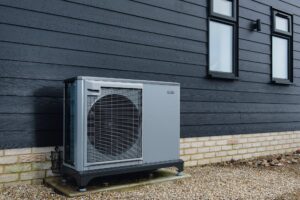
Retrofit with purpose: rethinking decarbonisation and design
Across the UK, the call for mass retrofit grows louder by the month. Buildings account for around 40 per cent of our carbon emissions, and if we are serious about meeting net zero targets, large-scale retrofit is non-negotiable. Yet despite the ambition, the path we are currently paving could make true scale impossible.
From May 29, 2025, new rules in England require all new Air Source Heat Pump (ASHP) installations to comply with the MCS 020a standard, but the new rules will not come into effect until May 29, 2026. From this date, all air source heat pump installations will be required to be MCS-approved.
This standard ensures that installations meet specific safety, efficiency, and quality requirements. From 2026, only MCS-approved ASHPs will be permitted under new rules, with each installation requiring a noise assessment. This regulation, though well-intentioned, risks creating a bottleneck at the very moment we need acceleration. The focus on a single technology, and the administrative burden that comes with it, threatens to slow progress on the national retrofit mission.
It’s time to broaden the conversation – and the toolkit.
The problem with a one-size-fits-all approach
ASHPs are a valuable technology, but they are not a universal solution. The current policy direction leans heavily on electrification as the single path to decarbonisation. While electrification is essential, retrofit demands a more nuanced view.
The UK’s building stock is one of the oldest and most diverse in Europe. Pre-war terraces, post-war estates, listed properties and modern flats all have different physical constraints. Plus, noise limits, planning permissions, and system compatibility varies from site to site. Applying one standardised approach ignores these realities.
The upcoming MCS-only rule could also create a skills gap. Smaller installers or innovative manufacturers not aligned with MCS standards may be locked out, reducing competition and stifling innovation. Meanwhile, the need for noise assessments on each property adds time and cost to a process already struggling with affordability and workforce capacity.
Retrofit should be enabling, not restrictive. Policy should encourage flexible pathways to decarbonisation – not create new barriers.
What intelligent retrofit looks like
True decarbonisation requires an intelligent mix of strategies that respond to the specific building, its users, and its local environment. At PRL, we see retrofit as a design challenge before it is a technical one.
A smart retrofit plan starts with a fabric-first approach - reducing heat demand through better insulation, airtightness, and moisture management. Once the building envelope performs efficiently, technology choices become simpler, smaller, and more cost-effective.
In many cases, ASHPs will play a central role, but they should sit within a diverse system that may also include:
- Hybrid heat pumps that combine air or ground sources with existing boilers during transition periods.
- District energy systems using waste heat recovery or renewable inputs.
- Solar thermal or PV integration to offset electrical loads.
- Smart controls and demand-side management, allowing buildings to adapt to grid conditions in real time.
Intelligent retrofit means selecting the right combination for each site - not forcing every property into the same mould. It’s about coordination and design thinking as much as hardware.
Scaling skills, not just systems
Technology will not deliver retrofit alone. People will.
To achieve scale, we must invest in the skills base that supports retrofit delivery. The current focus on product certification should be balanced with a national drive for training, apprenticeships, and retraining schemes. A skilled, local workforce will be the true engine of decarbonisation.
Regional retrofit hubs could serve as centres for training, supply, and quality assurance - providing local employment while supporting consistency. These hubs could also coordinate community-level retrofit, where streets or estates are upgraded as a single system rather than as isolated homes. This approach delivers economies of scale and ensures that retrofit outcomes: energy savings, comfort and carbon reduction are measurable and equitable.
At PRL, we’ve seen first-hand how collaboration between design teams, contractors and communities accelerates progress. When people understand the ‘why’ as well as the ‘how’, the results are transformative.
Designing for nature and biodiversity
Retrofit isn’t just about energy. It’s an opportunity to repair the relationship between the built environment and the natural world.
Nature and biodiversity restoration must be woven into the design of retrofit and new development alike. Every roof, wall and courtyard can be a micro-habitat. Every drainage system can be designed to enhance, not harm, local ecosystems.
Simple, replicable interventions can make a measurable difference:
- Green roofs and façades that absorb CO₂, filter particulates, and provide habitats for pollinators.
- Rain gardens and swales that reduce surface runoff, while improving biodiversity.
- Native planting schemes that support local species and reduce irrigation demand.
- Natural shading and ventilation that improve comfort, while cutting energy use.
These are not luxuries though - they are part of the infrastructure of resilience. The next generation of retrofit projects should deliver both low-carbon buildings and ecological recovery as standard.
The good news is that nature-positive design often complements retrofit goals. Green roofs add insulation and thermal stability. Shading from trees reduces cooling loads. Permeable surfaces help manage moisture, protecting fabric performance.
Designing with nature is not a cost – it’s an investment in our own wellbeing and long-term building health.
The built environment as a living system
We often treat buildings as isolated assets, when in reality they are part of a complex, living network of materials, energy, people and ecosystems. Viewing the built environment through this systems lens changes everything.
Digital tools now make it possible to map and manage these interconnections. Digital twins, Scan2BIM, and lifecycle data modelling give designers and operators continuous insight into how buildings perform and interact with their surroundings. The ‘golden thread’ of information ensures that design intent is carried through to construction, operation and eventual adaptation.
If we combine that data-driven intelligence with nature-based design, we can create buildings that are regenerative - not merely efficient. Buildings that contribute to their context, rather than consume from it.
This is where retrofit and biodiversity meet: a low-carbon, high-performance building that also restores green infrastructure and supports community wellbeing is the true measure of sustainable design.
From compliance to purpose
At present, retrofit policy often reads like a checklist; a series of compliance hurdles. What’s missing is vision.
If we want mass retrofit to succeed, we need to redefine what success looks like. It’s not just about kilowatt hours saved or tonnes of carbon avoided. It’s about creating places that work for people and planet.
That means:
- retrofit strategies flexible enough to suit every building type
- regulation that supports innovation, not restriction
- a skilled workforce equipped to deliver at scale
- retrofit outcomes that regenerate biodiversity, not deplete it.
The decarbonisation journey must evolve from a technology race to a design movement – one that connects carbon, nature and community in every decision we make.
At PRL, this is the direction we’re driving toward: retrofit with purpose, built on evidence, collaboration and care for the environment. Because sustainability isn’t just about lowering emissions – it’s about raising the standard for how we live, build and restore the world around us.
Carl Dodd, Property Revolutions Ltd.

